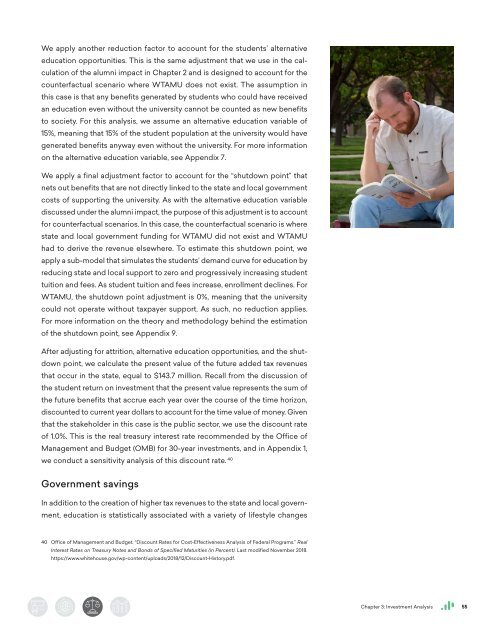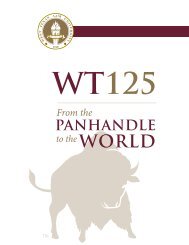The Economic Value of WTAMU Main Report
This report assesses the impact of West Texas A&M University (WTAMU) on the regional economy and the benefits generated by the university for students, taxpayers, and society. The results of this study show that WTAMU creates a positive net impact on the regional economy and generates a positive return on investment for students, taxpayers, and society.
This report assesses the impact of West Texas A&M University (WTAMU) on the regional economy and the benefits generated by the university for students, taxpayers, and society. The results of this study show that WTAMU creates a positive net impact on the regional economy and generates a positive return on investment for students, taxpayers, and society.
Create successful ePaper yourself
Turn your PDF publications into a flip-book with our unique Google optimized e-Paper software.
We apply another reduction factor to account for the students’ alternative<br />
education opportunities. This is the same adjustment that we use in the calculation<br />
<strong>of</strong> the alumni impact in Chapter 2 and is designed to account for the<br />
counterfactual scenario where <strong>WTAMU</strong> does not exist. <strong>The</strong> assumption in<br />
this case is that any benefits generated by students who could have received<br />
an education even without the university cannot be counted as new benefits<br />
to society. For this analysis, we assume an alternative education variable <strong>of</strong><br />
15%, meaning that 15% <strong>of</strong> the student population at the university would have<br />
generated benefits anyway even without the university. For more information<br />
on the alternative education variable, see Appendix 7.<br />
We apply a final adjustment factor to account for the “shutdown point” that<br />
nets out benefits that are not directly linked to the state and local government<br />
costs <strong>of</strong> supporting the university. As with the alternative education variable<br />
discussed under the alumni impact, the purpose <strong>of</strong> this adjustment is to account<br />
for counterfactual scenarios. In this case, the counterfactual scenario is where<br />
state and local government funding for <strong>WTAMU</strong> did not exist and <strong>WTAMU</strong><br />
had to derive the revenue elsewhere. To estimate this shutdown point, we<br />
apply a sub-model that simulates the students’ demand curve for education by<br />
reducing state and local support to zero and progressively increasing student<br />
tuition and fees. As student tuition and fees increase, enrollment declines. For<br />
<strong>WTAMU</strong>, the shutdown point adjustment is 0%, meaning that the university<br />
could not operate without taxpayer support. As such, no reduction applies.<br />
For more information on the theory and methodology behind the estimation<br />
<strong>of</strong> the shutdown point, see Appendix 9.<br />
After adjusting for attrition, alternative education opportunities, and the shutdown<br />
point, we calculate the present value <strong>of</strong> the future added tax revenues<br />
that occur in the state, equal to $143.7 million. Recall from the discussion <strong>of</strong><br />
the student return on investment that the present value represents the sum <strong>of</strong><br />
the future benefits that accrue each year over the course <strong>of</strong> the time horizon,<br />
discounted to current year dollars to account for the time value <strong>of</strong> money. Given<br />
that the stakeholder in this case is the public sector, we use the discount rate<br />
<strong>of</strong> 1.0%. This is the real treasury interest rate recommended by the Office <strong>of</strong><br />
Management and Budget (OMB) for 30-year investments, and in Appendix 1,<br />
we conduct a sensitivity analysis <strong>of</strong> this discount rate. 40<br />
Government savings<br />
In addition to the creation <strong>of</strong> higher tax revenues to the state and local government,<br />
education is statistically associated with a variety <strong>of</strong> lifestyle changes<br />
40 Office <strong>of</strong> Management and Budget. “Discount Rates for Cost-Effectiveness Analysis <strong>of</strong> Federal Programs.” Real<br />
Interest Rates on Treasury Notes and Bonds <strong>of</strong> Specified Maturities (in Percent). Last modified November 2018.<br />
https://www.whitehouse.gov/wp-content/uploads/2018/12/Discount-History.pdf.<br />
Chapter 3: Investment Analysis 55





